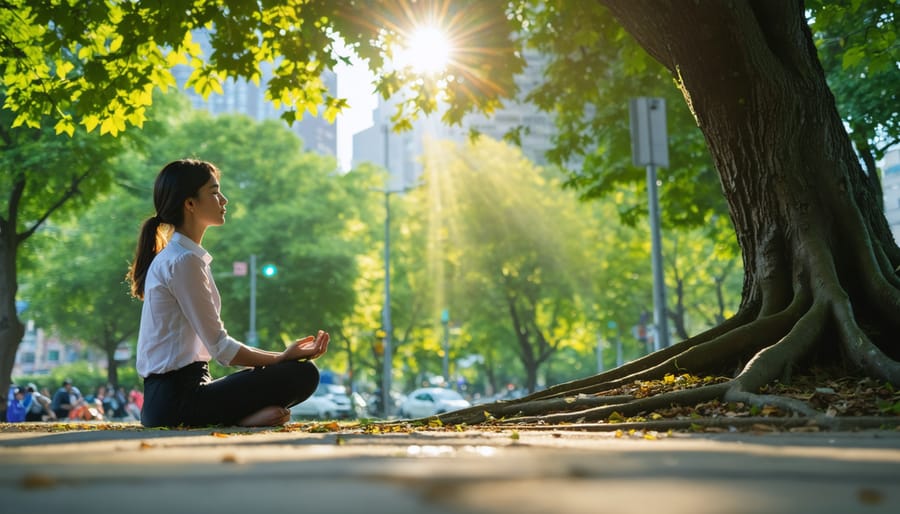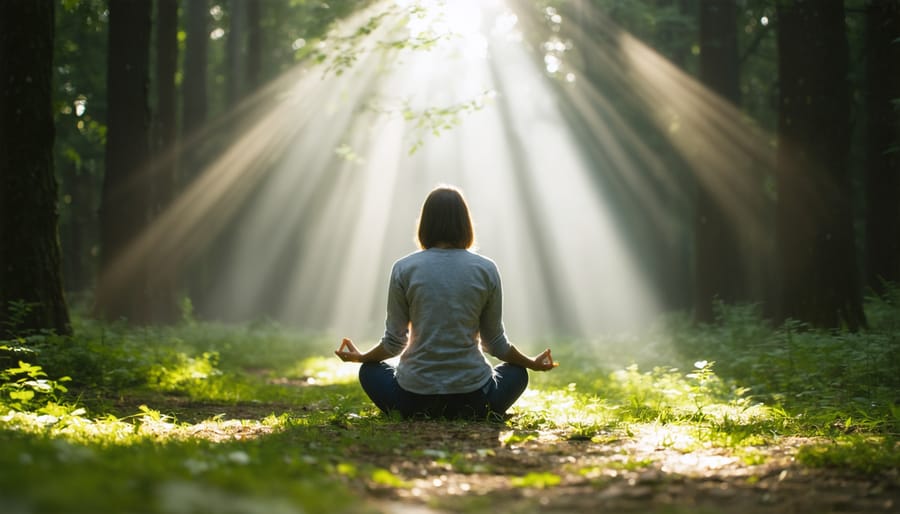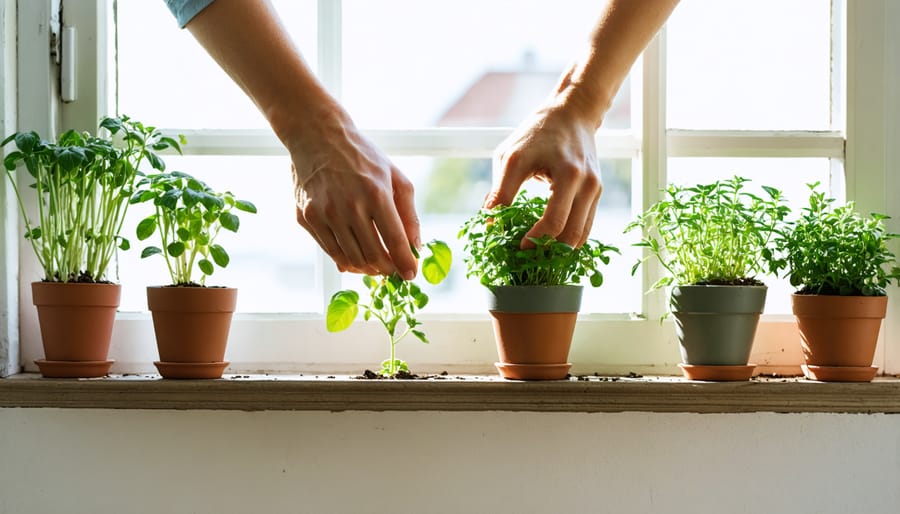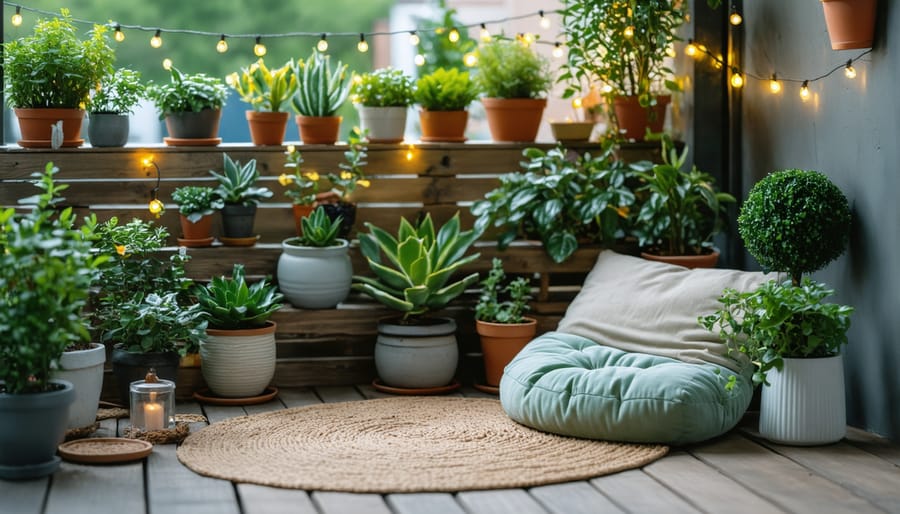
In a world where screens dominate and stress levels soar, nature holds an ancient key to our modern wellness. Ecotherapy – the practice of healing through intentional connection with the natural world – isn’t just another wellness trend; it’s backed by compelling research showing that just 20 minutes in nature can significantly lower stress hormones and boost mood.
Picture this: a stressed-out urban professional transforms her lunch break into a mini-retreat by simply sitting under a tree, breathing deeply, and feeling the grass beneath her feet. This isn’t just mindfulness; it’s medicine. Studies from leading institutions like Stanford University reveal that nature exposure reduces rumination (those pestering, negative thought patterns) and lowers activity in areas of the brain linked to depression.
The beauty of ecotherapy lies in its accessibility – you don’t need expensive equipment or a remote forest retreat to benefit. Whether it’s tending to a windowsill herb garden, taking meetings while walking in a local park, or simply watching birds from your balcony, nature’s healing power adapts to your lifestyle. This gentle yet powerful approach to wellness offers something increasingly rare in our fast-paced world: a chance to slow down, reconnect, and heal in harmony with the natural rhythms that have sustained humans for millennia.
The Science Behind Nature’s Healing Touch
Your Brain on Nature
Ever noticed how a walk in the park instantly lifts your mood? There’s fascinating science behind that natural high. When we immerse ourselves in nature, our brains undergo remarkable chemical changes that promote wellbeing and reduce stress.
Research shows that spending time in natural settings lowers cortisol (our stress hormone) while boosting feel-good chemicals like serotonin and dopamine. It’s like giving your brain a gentle, natural reset button. The simple act of breathing in fresh air and hearing birds chirp triggers your parasympathetic nervous system – your body’s relaxation response.
I experienced this firsthand during a particularly stressful period when daily garden breaks became my sanctuary. The combination of natural light exposure and greenery literally changed my brain’s electrical activity, promoting alpha waves associated with relaxation and creativity.
Even viewing nature through a window or having plants in your workspace can stimulate positive brain changes. These micro-doses of nature connection can improve focus, reduce anxiety, and enhance overall cognitive function. It’s remarkable how our brains are wired to respond so positively to the natural world – almost as if we’re meant to be connected to it.
The Stress-Relief Connection
Have you ever noticed how a simple walk in nature can make your worries melt away? There’s solid science behind that feeling. Research consistently shows that spending time in natural environments triggers significant physiological changes in our bodies, making nature one of the most effective stress reduction techniques available to us.
Studies reveal that just 20 minutes in nature can lower cortisol levels – our body’s primary stress hormone. When I take my morning walks in the local park, I can literally feel my shoulders relaxing and my breathing becoming deeper. This isn’t just a pleasant sensation; it’s your body responding to nature’s healing elements.
The Japanese practice of forest bathing (shinrin-yoku) has shown that natural environments increase our parasympathetic nervous system activity – the system responsible for rest and recovery. Exposure to natural settings has been linked to lower blood pressure, reduced muscle tension, and decreased heart rate.
What’s particularly fascinating is how even small doses of nature can make a difference. Whether it’s tending to houseplants, sitting in a garden, or watching birds from your window, these micro-connections with nature can provide meaningful stress relief in our busy lives.

Simple Nature-Based Wellness Practices
Mindful Garden Moments
Creating a mindful garden space isn’t just about growing plants; it’s about nurturing a deeper connection with nature and ourselves. As part of modern holistic healing practices, gardening offers a unique opportunity to slow down and engage all our senses in the present moment.
Start small by dedicating just 15 minutes to mindful gardening. Feel the texture of soil between your fingers, notice the subtle variations in leaf patterns, and breathe in the earthy aromas. Whether you’re tending to a sprawling backyard garden or caring for a few potted herbs on your windowsill, each interaction becomes a moment of meditation.
I’ve found that creating a simple morning ritual of watering plants while sipping tea can transform an ordinary task into a peaceful retreat. The gentle sound of water droplets hitting leaves and the sight of morning light filtering through green foliage naturally grounds us in the present moment.
For apartment dwellers, a collection of indoor plants can become your personal sanctuary. Choose plants that speak to you – perhaps a peace lily for its air-purifying qualities or a string of pearls for its unique texture. The act of pruning, repotting, and nurturing these green companions becomes a form of active meditation, helping to quiet the mind while connecting us to the natural rhythms of growth and renewal.
Forest Bathing for Beginners
Have you ever wished you could press a reset button for your mind and body? That’s exactly what forest bathing offers – and no, it doesn’t involve getting wet! Also known as shinrin-yoku in Japanese, forest bathing is like combining mindful meditation practices with a gentle nature walk.
I discovered forest bathing during a particularly stressful period in my life, and it’s become my go-to practice for finding calm and clarity. The concept is beautifully simple: you immerse yourself in the forest atmosphere, using all your senses to connect with nature. Unlike hiking, where reaching a destination is the goal, forest bathing is all about being present in the moment.
To try it yourself, find a quiet natural space – it doesn’t need to be a vast forest; a local park with trees works perfectly. Start by taking slow, deliberate steps. Notice how the ground feels beneath your feet. Listen to the rustling leaves, breathe in the earthy scents, and observe the patterns of light filtering through the canopy. Touch the rough bark of trees, feel the cool morning air on your skin, and simply let your thoughts drift like clouds.
Research shows that just two hours of forest bathing can lower stress hormones, reduce blood pressure, and boost immune function. It’s nature’s antidote to our fast-paced digital lives, offering a moment of pure connection with the natural world.
Urban Nature Connection
Living in the city doesn’t mean you have to miss out on nature’s healing benefits. As a former apartment dweller who struggled to find green spaces, I’ve discovered countless ways to connect with nature even in the most urban environments. The key is to shift your perspective and start noticing the natural world that exists within our concrete jungle.
Start by seeking out your neighborhood’s pocket parks, community gardens, or tree-lined streets. Even a 15-minute lunch break spent sitting under a street tree can help reduce stress and improve your mood. Window boxes, balcony gardens, and indoor plants can create your own mini sanctuary, bringing nature’s calming presence right into your living space.
Make it a habit to notice the subtle ways nature appears in the city: the determined dandelion pushing through sidewalk cracks, birds nesting in building ledges, or the way sunlight creates patterns through leaves. These small moments of connection can be just as meaningful as a walk in the woods.
Urban nature spots often become community gathering places too. Join a local gardening group, participate in park clean-ups, or start a nature appreciation club in your area. Many cities now offer guided urban nature walks, helping residents discover hidden green spaces and learn about local flora and fauna.
Remember, nature connection isn’t about finding pristine wilderness – it’s about appreciating and engaging with the natural elements that surround us every day, no matter where we live.
Creating Your Natural Wellness Sanctuary
Indoor Nature Retreats
Not everyone has immediate access to sprawling gardens or forest trails, but that doesn’t mean you can’t create your own natural sanctuary indoors. I learned this firsthand during a particularly challenging winter when bringing nature inside became my daily dose of serenity.
Start by introducing living plants into your space – they’re not just decorative elements but active participants in your wellness journey. Snake plants and pothos are perfect for beginners, while peace lilies can transform any room into a tranquil retreat. Consider creating a dedicated green corner where you can sit and practice mindful breathing among your leafy companions.
Natural materials and textures play a crucial role too. Incorporate wooden furniture, bamboo accessories, or stone elements to maintain that connection with nature. A small tabletop fountain can provide the soothing sounds of flowing water, while essential oils derived from trees and flowers can recreate forest aromatherapy at home.
Light is another vital element – position your workspace or relaxation area near windows to maximize natural sunlight exposure. For darker spaces, full-spectrum lights can mimic natural daylight and help maintain your circadian rhythm. Display nature photography or artwork featuring landscapes to create visual connections with the outdoors.
Remember, even small touches matter – a collection of shells, pinecones, or smooth river stones can serve as mindful touchstones throughout your day, keeping you connected to nature’s healing presence no matter where you are.

Balcony and Patio Wellness Spaces
Even if you live in an apartment or have limited outdoor space, you can create a serene natural sanctuary right on your balcony or patio. I’ve transformed my tiny urban balcony into a peaceful retreat, and I’m excited to share how you can do the same.
Start by incorporating potted plants that engage multiple senses. Lavender releases calming aromatherapy benefits, while rustling ornamental grasses provide soothing sound therapy. Consider vertical gardening solutions to maximize space – wall-mounted planters or hanging baskets can create a lush green backdrop without sacrificing floor space.
Create a comfortable seating area with weather-resistant cushions and throws. I’ve found that natural materials like bamboo or wicker furniture help maintain that connection with nature. Add a small water feature, like a tabletop fountain, to introduce the peaceful sound of flowing water.
Define your meditation space with outdoor rugs or bamboo mats, and incorporate mindful touches like wind chimes or crystal suncatchers. Solar-powered fairy lights can extend your nature time into the evening hours, creating a magical atmosphere for twilight meditation sessions.
Don’t forget to include practical elements like shade solutions – a retractable awning or umbrella can make your outdoor sanctuary comfortable in various weather conditions. Even the smallest outdoor space can become a powerful tool for ecotherapy when thoughtfully designed with wellness in mind.
Remember, your balcony or patio wellness space should reflect your personal needs and preferences while maintaining that vital connection to the natural world.

Seasonal Nature Connection Rituals
Spring and Summer Practices
As the world bursts into bloom, spring and summer offer countless opportunities to deepen your nature connection practice. I love starting my day with a mindful breakfast on my tiny balcony, watching the morning light filter through the leaves while listening to birdsong. Even this simple ritual can shift your entire mood.
Try walking barefoot through dewy grass – a practice known as “earthing” that many find deeply grounding. Garden therapy becomes especially rewarding during these warmer months; there’s something magical about nurturing seedlings into flourishing plants. Even if you only have windowsill space, growing herbs or microgreens can provide that vital connection to nature’s rhythms.
Beach therapy is another powerful summer practice. The combination of negative ions from crashing waves, vitamin D from sunshine, and the meditative sound of the ocean creates the perfect environment for natural healing. If you’re not near the coast, seek out local parks or green spaces for forest bathing – simply being present among trees has been shown to reduce stress hormones.
Make the most of longer daylight hours by taking your exercise outdoors. Whether it’s yoga in the park, a nature photography walk, or outdoor meditation, moving your wellness routine outside amplifies its benefits. Remember to engage all your senses: feel the warm breeze, smell the blooming flowers, taste fresh berries, and watch butterflies dance through your garden.
Fall and Winter Wellness
When the days grow shorter and temperatures drop, many of us instinctively retreat indoors. However, maintaining our nature connection during fall and winter is crucial for year-round wellness. I discovered this myself during a particularly challenging winter when daily “frost walks” became my saving grace.
Start by reframing cold weather as an opportunity for unique seasonal experiences. Bundle up in cozy layers and embrace the crisp air during a morning walk – there’s something magical about being the first to leave footprints in fresh snow or watching your breath create delicate clouds in the frosty air.
Create an inviting outdoor space that beckons you year-round. Set up a sheltered seating area with weather-resistant cushions and warm blankets. Keep a thermos of hot tea or cocoa ready for outdoor meditation sessions. Bird feeders can transform your yard or balcony into a winter wildlife sanctuary, providing endless entertainment and connection to nature’s rhythms.
Indoor nature connection is equally valuable during harsh weather. Nurture houseplants, create a small indoor herb garden, or bring natural elements inside through pine cones, branches, and seasonal decorations. The soft glow of himalayan salt lamps and nature soundscapes can help maintain that outdoor ambiance when you’re stuck inside.
Remember, even brief moments of nature connection count. A five-minute morning ritual of opening your windows for fresh air or watching snowfall can ground you in the season’s unique beauty.
As we’ve explored together, the healing power of nature isn’t just a poetic notion – it’s a scientifically-backed path to better mental and emotional wellbeing. Whether you start with a five-minute mindful moment in your local park or commit to weekly forest bathing sessions, every step toward nature connection is a step toward healing. Remember, there’s no “right way” to practice ecotherapy – your journey is as unique as you are. The key is to begin where you are, with what you have available. Start small, stay consistent, and watch as your relationship with nature deepens and transforms. Your garden, neighborhood park, or even a sunny windowsill can become your sanctuary for natural healing. Why not take that first step today? Nature is waiting to welcome you home to yourself.



